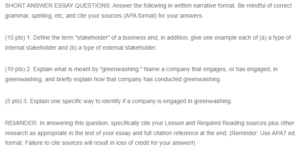Stakeholder and Greenwashing
Stakeholder Definition
According to Benn et al. (2016), a stakeholder refers to a party with an interest in a company, and they are affected by the actions of a business or directly affect the industry with their actions. Notably, the traditional definition of a stakeholder has since been modified due to the emergence of corporate social responsibility. Now, stakeholders include the government, communities, and trade associations.
Do you need an unpublished version of ” Stakeholder and Greenwashing “ ? Reach out to us.
Example of Internal Stakeholder
The activities of a company directly and significantly impact internal stakeholders. An excellent example of an internal stakeholder is an investor (Benn et al., 2016). For instance, if an individual investor commits $1m to a startup and expects a 10% equity return, they are affected by a company’s actions. Such a stakeholder has a vested interest in a company’s equity. The success or failure of a company will determine whether investors get their returns.
Example of External Stakeholder
On the other hand, external stakeholders do not have a direct relationship with a company. The actions of a business may not affect the external stakeholder significantly and directly, as is the case with internal stakeholders (Benn et al., 2016). For instance, if a company operating in a local town produces excess carbon emissions, then the impacts hit the population in that town. To that end, the public is the external stakeholder of the emitting company. Another external stakeholder is the government. If the government makes policy changes, they will affect the business even if there is no direct link between a business and the government.
Question 2
Greenwashing
Greenwashing refers to creating false impressions or providing misleading information about a company’s footprint in environmental degradation. The practice involves lying to consumers that a company’s products are environmentally friendly but not (de Freitas Netto et al., 2020). Companies participating in greenwashing intend to keep a positive image to retain customers in an era where consumers have become ecologically aware. For instance, some companies lie that their products are recycled to make customers trust them.
An example of a company that has engaged in greenwashing is Walmart. In April 2022, it was alleged that the retailer falsely marketed two textile products as having been made from bamboo using eco-friendly processes (Federal Trade Commission, 2022). However, it was established that the two items initially wrongfully marketed were made from rayon. It turns out that rayon is made by combining bamboo and some chemical products, which leave significant adverse environmental impacts. The company was fined $3 million by the Federal Trade Commission (FTC).
Question 3
Identifying Greenwashing
Stakeholders and regulatory bodies can tell whether a company is participating in greenwashing. Advertisements provide platforms for some companies to pronounce their environmental practices falsely (de Freitas Netto et al., 2020). One should look for vague statements in advertisements to identify if a company is committing greenwashing. For instance, a Ryanair advert in 2019 claiming that the airline produces the lowest emissions in Europe was banned. The ad was denied because the company did not provide evidence to support its claims.
Also, companies practising greenwashing use buzzwords such as ‘eco’, ‘natural’, and ‘green’ on their products. It turns out that such labelling is not backed by any scientific standards but a mere deceptive campaign to influence consumers’ purchasing behaviour. Companies that practice environmentally friendly production rarely seek validation from the outset.
Another way to investigate if firms practice greenwashing is by looking at the extent of hidden information. For instance, some firms may claim environmental responsibility while ignoring the environmentally degrading practices in factories along the supply chain (de Freitas Netto et al., 2020). Besides, some companies hide information, like Shell, which lied about using all their carbon dioxide waste to grow plants. It turned out the company was using a fraction of their emissions.
References
Benn, S., Abratt, R., & O’Leary, B. (2016). Defining and Identifying Stakeholders: Views from Management and Stakeholders. South African Journal of Business Management, 47(2), 1–11. https://doi.org/10.4102/sajbm.v47i2.55
de Freitas Netto, S. V., Sobral, M. F. F., Ribeiro, A. R. B., & Soares, G. R. da L. (2020). Concepts and forms of greenwashing: a systematic review. Environmental Sciences Europe, 32(1). https://doi.org/10.1186/s12302-020-0300-3
Federal Trade Commission. (2022, April 8). $5.5 million total FTC settlements with Kohl’s and Walmart challenge “bamboo” and eco claims, shed light on Penalty Offense enforcement. Federal Trade Commission. https://www.ftc.gov/business-guidance/blog/2022/04/55-million-total-ftc-settlements-kohls-and-walmart-challenge-bamboo-and-eco-claims-shed-light
ORDER A PLAGIARISM-FREE PAPER HERE
We’ll write everything from scratch
Question
SHORT ANSWER ESSAY QUESTIONS: Answer the following in written narrative format. Be mindful of correct grammar, spelling, etc, and cite your sources (APA format) for your answers.

Stakeholder and Greenwashing
(15 pts) 1. Define the term “stakeholder” of a business and, in addition, give one example each of (a) a type of internal stakeholder and (b) a type of external stakeholder.
(10 pts) 2. Explain what is meant by “greenwashing.” Name a company that engages, or has engaged, in greenwashing, and briefly explain how that company has conducted greenwashing.
(5 pts) 3. Explain one specific way to identify if a company is engaged in greenwashing.
REMINDER: In answering this question, specifically cite your Lesson and Required Reading sources plus other research as appropriate in the text of your essay and full citation reference at the end. (Reminder: Use APA7 ed. format. Failure to cite sources will result in loss of credit for your answer!)
NO PLAGIARISM OR REUSING SENTENCES. Use your own words. Thank you.
USE: Grefen, P. (2015). Beyond e-business: towards networked structures. Routledge.
James Chen (2020). Stakeholder. Retrieved fromhttps://www.investopedia.com/terms/s/stakeholder.asp#:~:text=A%20stakeholder%20is%20a%20party,employees%2C%20customers%2C%20and%20suppliers

